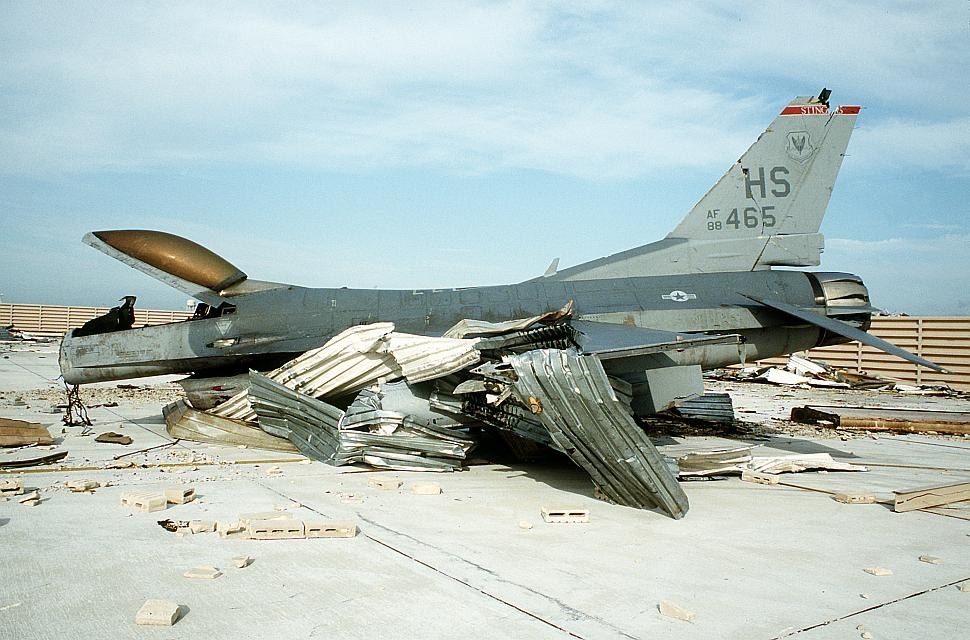
On Friday, the Air Force revealed that “a number of aircraft” had been left behind in hangars on Tyndall Air Force Base in Florida when the state sustained a direct hit from Hurricane Michael this week, causing what the base command called “widespread catastrophic damage.”
The storm damaged virtually every structure on the base, tearing off roofs, downing power lines, and destroying the hangars where planes that could not be flown out ahead of Michael’s landfall had been sheltered. Aerial photos and videos of the aftermath showed aircraft covered in debris inside the ruined hangars, which were torn apart by 155 mph winds.
The more than 3,300 active-duty personnel and their 5,000 family members had all been evacuated before the storm hit Wednesday afternoon, and there were no injuries or casualties, the Air Force said.
Still, the widespread devastation on the base is likely to cost hundreds of millions of dollars to repair, not counting whatever damage has been done to the fighter aircraft that remained on the base as the storm came ashore. It may be some time before the full impact of the storm is realized, and there was already speculation about whether the Pentagon would scrap the base, whose facilities the Air Force valued at $3.4 billion in 2017, rather than rebuild.
While most aircraft were evacuated to a base in Ohio, some of them had to be left behind due to maintenance or safety reasons, the Air Force said on Friday.
Aerial images showed what appeared to be F-22 Raptor aircraft through the destroyed roofs of the hangars.
“All of those hangars are damaged,” Air Force spokesperson Ann Stefanek told BuzzFeed News in an email. “We anticipate the aircraft parked inside may be damaged as well, but we won't know the extent until our crews can safely enter those hangars and make an assessment.”
So one F-22 airframe has been spotted in a roofless hangar at Tyndall. Check out the upper left portion of this photo. No idea if this is flying airframe or a ground trainer or what, but it doesn't look good. More on Tyndall AFB's sad state here: https://t.co/JikiO65eny https://t.co/GlvQ6hnJP7
Tyndall is the home of the 325th Fighter Wing and provides training for all F-22 Raptor pilots in the US. It houses the US military’s largest group of the stealth F-22 fighters — roughly 55 of them. Although the Air Force would not confirm which aircraft had been left behind and likely damaged, the Air Force Forum Facebook page, citing a source at Tyndall, said four F-22s were in the destroyed hangars. Defense One also reported that the F-22s were left behind.
If true, it would be a major loss for the Air Force, which has only 187 of the jets. Each F-22 is valued at between $163 million and $339 million.
Despite pledges to repair the damage, the apparent extent of the destruction raises questions about the future of the base, with some recalling the fate of Homestead Air Force Base in South Florida, which was decimated by Hurricane Andrew in 1992.
Homestead was considered a showpiece for the Air Force, with 4,400 active-duty military personnel and roughly the same number of civilian employees working on a well-tended, 3,345-acre installation lined with palm trees.

In August 1992, Hurricane Andrew destroyed 80% of the base. The Pentagon initially budgeted $76 million to partially rebuild it after the storm, and former president George H.W. Bush asked Congress to pass a $480 million reconstruction package. But the bill failed and Homestead landed on the list of military bases slated to shut down a year later. Its personnel and aircraft were reassigned, and two years later it reopened as a much smaller Air Force Reserve base. For similar reasons, the US military abandoned Clark Air Force Base in the Phillippines after much of it was destroyed by a volcanic eruption in 1991.
Now Tyndall is facing a similarly daunting prospect, as military officials assess the damage and determine how to best rebuild — and fund — the ravaged installation.
“The flight line is devastated. Every building has severe damage. Many buildings are a complete loss. The hurricane completely destroyed the Tyndall marina. The structures and docks are gone,” Col. Brian Laidlaw, the 325th Fighter Wing’s commander, wrote to the base’s personnel, noting that the drone runway had also been destroyed. “Our area has never seen a storm like this one. We will rebuild together.”
The base remained closed on Friday, with trees and power lines blocking nearly every road around the base, and no power or basic utilities, according to Tyndall officials.
Previously, as many other bases faced shutdowns through the Base Realignment and Closure process (BRAC), Florida lawmakers promised that Tyndall’s training role would protect it. The base estimates that its impact on the local economy is in excess of $596 million annually.
"Tyndall doesn't have any means of getting closed, because Tyndall is a critical training area for Air Force pilots," Sen. Bill Nelson, a Florida Democrat, said in 2003. “Tyndall is locked solid to be secure through the BRAC process.”
In a letter to Air Force Secretary Heather Wilson on Friday, Nelson, Sen. Marco Rubio and Rep. Neal Dunn, who represents the district of the base, wrote that they would be committed to seeing it "rebuilt and return stronger than ever."
"Each of us stand ready to work with the Air Force to rebuild Tyndall AFB and advocate for the resources needed to do so," the Florida lawmakers wrote, saying the operations at the base were "critical to national security."
The Air Force would not comment on how long it expects F-22 training to be suspended.
“The Air Force remains capable of executing its combat mission across the world with aircraft from other bases, as well as those that were evacuated from Tyndall in advance of the hurricane,” Stefanek, the Air Force spokesperson, said.
